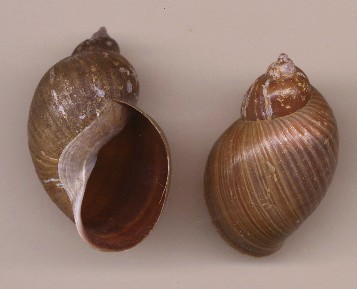Classification
Bulimnea megasoma is a very complex species! Below is the classification tree, along with descriptions that describe each part. I couldn't believe at first how such a little critter could have such a complex history.
Domain: Eukarya
Kingdom: Animalia
Phylum: Mollusca
Class:
Gastropoda
Subclass: Pulmonata
Order: Basommatophora
Family: Lymnaeidae
Genus: Bulimnea
Species: Bulimnea megasoma
(AnimalDiversity
2000)
Domain: Eukarya includes all organisms that have
membrane-bound nuclei
(Hickman et al 2009).
Kingdom: Animalia is characterized by evolutionary traits that separate each animal into an organizational level such as being multicellular and all are heterotrophs. Most ingest food into an internal cavity (Hickman et al 2009, Animal Diversity 2000).
Phylum: Mollusca is one of the largest animal phylums and means soft bodied. Characteristics include having a mantle, visceral mass, head-foot, and radula, which is their way of bringing in food (Hickman et al 2009).
Class: Gastropoda is the largest class of molluscs that include snails, conchs, and slugs just to name a few. Most are sluggish and sedentary and have bilateral symmetry while developing torsion (Hickman et al 2009).
Subclass: Pulmonata contains all land and terrestrial snails (AnimalDiversity 2000).
Order: Basommatophora includes snails with eyes at the end of their tentacles (AnimalDiversity 2006).
Family: Lymnaeidae have triangular tentacles and their heads are spilt into 2 flat lobes (AnimalDiversity 2006).
Genus: Bulimnea have large shells which are normally dark brown or purple in color and make it easily recognizable from other snails ( Pip 1985).
Species: Bulimnea megasoma is the only species that belongs to the Genus Bulimnea that is characterized by a 6 whorl shell (Ashmead et al 1899).

